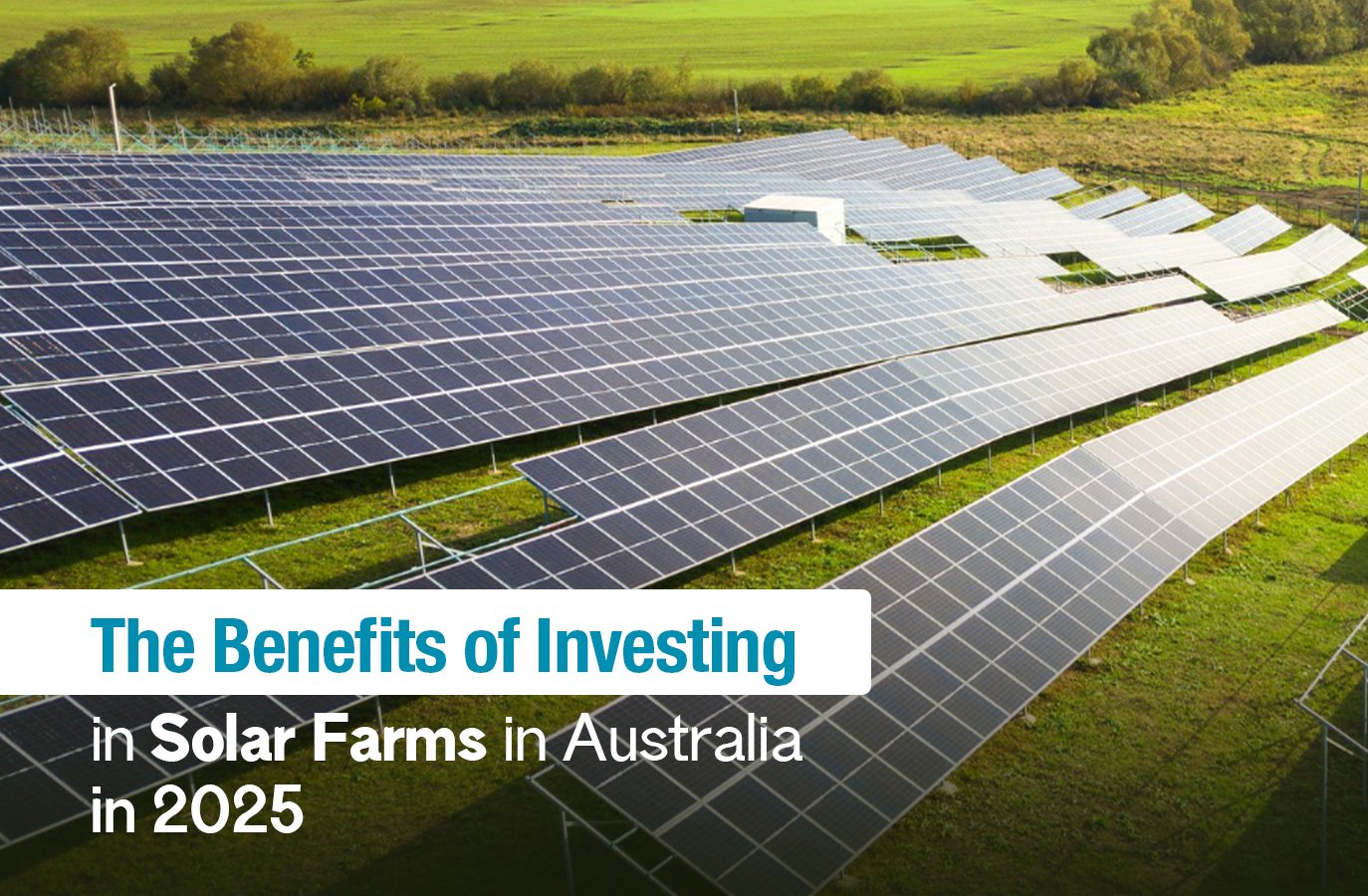As Australia continues to embrace renewable energy, solar farms are at the forefront of this shift, offering numerous advantages for both the environment and economy. In 2025, solar energy remains one of the most promising investment opportunities for landowners, businesses, and communities alike. With Australia’s vast landmass and abundant sunlight, the potential for solar farm development is immense, making it a sound financial decision for those looking to contribute to the nation’s sustainable future.
Recent data shows that Australia has become a global leader in solar energy, with over 3 million solar installations already in place. Solar farms, particularly in regions like Sydney, are gaining traction as essential components of the country’s green energy revolution. These investments offer benefits ranging from long-term financial returns to helping reduce carbon footprints. In this article, we explore why 2025 is the perfect time to invest in solar farms in Australia, and how solar installations in Sydney are transforming the energy landscape.
1. The Rise of Solar Farms in Australia: A 2025 Perspective
In recent years, solar farms have become increasingly popular in Australia due to their potential to provide renewable, sustainable energy while generating substantial returns for investors. The Australian government’s commitment to reducing carbon emissions and promoting renewable energy has provided a solid foundation for the growth of solar farms, particularly in areas like Sydney.
By 2025, solar farms are expected to become an even more integral part of Australia’s energy mix. With advancements in solar panel technology, decreasing installation costs, and improved efficiency, these solar installations are more accessible and economically viable than ever. For those considering a long-term investment, solar farms provide an opportunity to capitalise on Australia’s abundant sunshine, which makes the country ideal for large-scale solar power generation.
This trend is not only a result of government incentives but also a growing awareness among businesses and landowners about the environmental and financial benefits of solar farms. In Sydney, the urban energy transition is particularly noticeable, with businesses increasingly opting for solar installations to meet both regulatory standards and sustainability goals. As energy demand rises and renewable energy initiatives expand, solar farms offer a promising solution for the future.
2. Financial Benefits of Solar Farms in Australia
One of the most compelling reasons to invest in solar farms in Australia is the potential for long-term financial returns. As the cost of solar technology continues to decrease, installing solar farms is becoming a more affordable investment. In fact, Australia’s solar farm sector has witnessed a massive drop in the cost of solar panels over the past decade, making it a viable investment for both large-scale developers and smaller landowners.
For instance, commercial solar farms can generate substantial returns through the sale of electricity back to the grid, benefiting from Australia’s renewable energy targets and government subsidies. With over 10,000 megawatts of solar power capacity already installed, this industry continues to grow, presenting new opportunities for profit. Additionally, government incentives like the Small-Scale Renewable Energy Scheme (SRES) can further reduce upfront costs and boost overall profitability.
In Sydney, businesses investing in solar installations also benefit from reduced electricity bills. With a significant number of companies turning to solar, the city is becoming a leader in sustainable energy practices. By investing in solar, both businesses and landowners not only save money but also contribute to the community’s energy independence. Over time, the initial investment in solar farms can be recovered through energy savings, along with the added benefit of stable revenue streams from government-backed initiatives and renewable energy credits.
3. Environmental Impact and Sustainability of Solar Farms
Apart from the financial benefits, solar farms play a significant role in contributing to Australia’s environmental sustainability efforts. The Australian government has set ambitious targets to reduce carbon emissions, with renewable energy sources like solar being at the forefront of this transition. By investing in solar farms, you’re not just making a sound financial choice – you’re also contributing to the reduction of greenhouse gases and promoting cleaner energy solutions.
Solar energy is one of the cleanest forms of power generation, producing little to no emissions during operation. This makes solar farms an ideal solution for reducing Australia’s reliance on fossil fuels, which are responsible for a substantial portion of the country’s carbon footprint. As of 2025, Australia aims to significantly increase its share of renewable energy, and solar farms are key to meeting these targets.
In areas like Sydney, where urban sprawl and increased energy demand often lead to higher carbon emissions, solar farms offer a means of offsetting these effects. Solar panels can help reduce the need for traditional, polluting power plants, providing a much-needed boost to energy sustainability in metropolitan areas. Additionally, landowners and businesses investing in solar farms can often combine energy generation with agricultural activities, further promoting sustainable land use and farming practices.
4. Solar Farms: A Long-Term Investment in Energy Independence
As energy prices fluctuate and global markets become more volatile, investing in solar farms presents a unique opportunity for long-term energy security and independence. One of the most attractive features of solar farms is their ability to generate electricity consistently, reducing reliance on traditional energy sources like coal or natural gas. This is particularly crucial for Australia, where energy prices have been rising due to increased demand and supply issues.
By 2025, more Australians are expected to turn to solar energy to shield themselves from unpredictable price hikes and supply shortages. This trend is evident in places like Sydney, where residential and commercial solar installations are becoming a popular choice for reducing energy costs. Solar farms offer a reliable, consistent energy source that can help protect businesses and homeowners from future price increases and energy disruptions.
Furthermore, as the solar energy sector continues to expand, it will provide more opportunities for Australians to become energy self-sufficient. Landowners and businesses that invest in solar farms are not only helping to power their own operations but are also contributing to the country’s broader energy independence goals. This shift towards renewable energy will play a pivotal role in Australia’s transition to a more sustainable and self-reliant energy future.
5. Enhancing Agricultural Productivity with Solar Farms
In Australia, agriculture plays a vital role in the economy, and solar farms can provide a dual benefit for farmers and landowners looking to improve both their energy output and agricultural productivity. By integrating solar energy into agricultural operations, farmers can reduce energy costs while simultaneously contributing to the nation’s renewable energy goals.
One of the key advantages of solar farms in agricultural areas is the potential for “agriculture-plus-solar” projects, where land used for farming can be shared with solar panel installations. This innovative approach, often referred to as agrivoltaics, allows farmers to generate electricity while continuing to use the land for crops or livestock. For example, in some regions of Australia, solar farms are being built above grazing land or crop fields, providing shade to the crops below while producing valuable solar energy.
This combination of agriculture and solar energy not only boosts a farm’s revenue but also provides a more resilient farming model, as it reduces energy dependence and offers potential income from selling excess power to the grid. In regions like Sydney, where agricultural land is in close proximity to urban centres, this model of combining solar installations with farming is gaining popularity as a way to make farming operations more financially sustainable while advancing the clean energy transition.
6. Government Support and Incentives for Solar Farm Investment
One of the strongest driving forces behind the growth of solar farms in Australia is the government’s support through incentives and rebates. In 2025, the Australian government is expected to continue its focus on promoting renewable energy, offering both financial incentives and regulatory support for those investing in solar energy.
Several programs are available to support solar farm projects, including the Large-Scale Renewable Energy Target (LRET), which provides incentives for the generation of renewable energy. Additionally, the Clean Energy Finance Corporation (CEFC) offers loans and financing options to developers and landowners interested in solar projects. These initiatives help offset the initial costs of solar farm development and make it more accessible for investors looking to tap into the growing renewable energy market.
For businesses in Sydney, the government’s financial backing is a significant advantage. Local businesses can access various subsidies and grants, reducing the financial burden of installing solar panels or developing larger solar farm projects. These incentives can significantly improve the return on investment for solar farm owners, making it an even more appealing long-term investment.
Conclusion:
As we look towards 2025, investing in solar farms in Australia represents a forward-thinking, sustainable, and profitable decision for both landowners and businesses. With government support, technological advancements, and an increasing demand for renewable energy, solar farms offer unparalleled opportunities to generate long-term financial returns while contributing to a greener, more energy-independent future.
From the financial incentives available to the environmental benefits of reducing carbon emissions, solar farms are more than just an investment in energy—they’re an investment in Australia’s sustainable future. Whether you’re located in Sydney or elsewhere across the nation, the time to explore solar energy solutions is now.
At Aussie Home Improvement, we’re here to guide you through every step of the process, ensuring that your solar farm investment is not only environmentally impactful but also financially rewarding. Start planning today and be part of Australia’s renewable energy revolution.
Frequently Asked Questions (FAQs) about Solar Farms in Australia
1. What is a solar farm?
A solar farm is a large-scale installation of solar panels that generate electricity from sunlight. These farms are often located in rural or suburban areas where there is ample space and sunlight, making them ideal for energy production. Solar farms in Sydney and across Australia are increasingly being used to provide clean, renewable energy to the national grid.
2. Why should I invest in a solar farm in Australia?
Investing in a solar farm in Australia is a smart choice due to the country’s high solar energy potential. With government incentives, tax rebates, and the growing demand for renewable energy, solar farms provide long-term financial returns while contributing to environmental sustainability. Additionally, solar installations in Sydney can help reduce energy costs for businesses and homeowners alike.
3. How much does it cost to install a solar farm in Australia?
The cost of installing a solar farm in Australia varies depending on the size and location of the project. However, with decreasing solar panel prices and various government incentives, the upfront costs are becoming more affordable. For solar installations in Sydney, businesses can expect to benefit from financial subsidies, making the investment more accessible.
4. What are the environmental benefits of solar farms?
Solar farms are a significant contributor to reducing carbon emissions, as they generate clean, renewable energy. By investing in solar energy, Australia can reduce its reliance on fossil fuels and help mitigate climate change. Solar energy also offers long-term sustainability by providing a renewable energy source without harmful pollutants.
5. Can solar farms help reduce energy costs for businesses in Sydney?
Yes! By investing in solar installations in Sydney, businesses can significantly reduce their energy bills. Solar farms allow companies to generate their own electricity, reducing the need to purchase expensive power from the grid. Additionally, government incentives make solar energy an even more attractive option for businesses looking to cut down on operating costs.
6. What government incentives are available for solar farm investments in Australia?
The Australian government offers several incentives for those investing in solar energy, including the Small-Scale Renewable Energy Scheme (SRES) and the Large-Scale Renewable Energy Target (LRET). These programs help reduce the upfront costs of solar installations and provide ongoing support for the generation of renewable energy. Businesses in Sydney can also access subsidies to encourage the adoption of solar power.
7. How long does it take to see a return on investment from a solar farm?
The return on investment (ROI) for solar farms typically ranges from 5 to 10 years, depending on the size of the installation and the energy savings generated. For businesses, ROI can be quicker due to the ability to reduce energy costs and take advantage of government incentives. In Sydney, the growing demand for renewable energy makes solar farm investments more lucrative.
8. Are solar farms a good investment for farmers in Australia?
Yes, solar farms are an excellent investment for farmers, especially through agrivoltaics, where solar panels are integrated with agricultural land. This setup allows farmers to produce clean energy while maintaining agricultural operations. The income generated from selling excess energy to the grid can supplement a farmer’s income, making it a viable option for many in rural and suburban areas.



